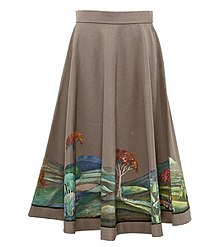dead or dying palm fronds gathered down the stem of a palm. which may be removed for aesthetic or safety reasons.
A skirt is the lower part of a dress or a separate outer garment that covers a person from the waist downwards. Originally made for both genders, it is currently made mainly for females.
 | |
| Type | Clothing worn from the waist or hips. |
|---|---|
| Material | fabric |
At its simplest, a skirt can be a draped garment made out of a single piece of fabric (such as pareos). However, most skirts are fitted to the body at the waist or hips and fuller below, with the fullness introduced by means of darts, gores, pleats, or panels. Modern skirts are usually made of light to mid-weight fabrics, such as denim, jersey, worsted, or poplin. Skirts of thin or clingy fabrics are often worn with slips to make the material of the skirt drape better and for modesty.
In modern times, skirts are very commonly worn by women and girls. Some exceptions include the izaar, worn by many Muslim cultures, and the kilt, a traditional men's garment in Scotland, Ireland, and sometimes England. Fashion designers such as Jean Paul Gaultier, Vivienne Westwood, Kenzo and Marc Jacobs have also shown men's skirts. Transgressing social codes, Gaultier frequently introduces the skirt into his men's wear collections as a means of injecting novelty into male attire, most famously the sarong seen on David Beckham.
The hemline of skirts can vary from micro to floor-length and can vary according to cultural conceptions of modesty and aesthetics as well as the wearer's personal taste, which can be influenced by such factors as fashion and social context. Most skirts are complete garments, but some skirt-looking panels may be part of another garment such as leggings, shorts, and swimsuits.

